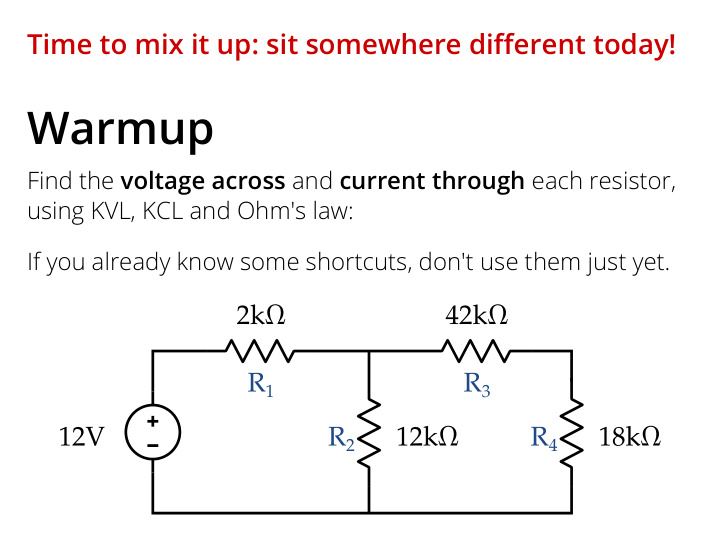



Time to mix it up: sit somewhere di ff erent today! Warmup Find the voltage across and current through each resistor, using KVL, KCL and Ohm's law: If you already know some shortcuts, don't use them just yet. 2k Ω 42k Ω R 1 R 3 12V R 2 12k Ω R 4 18k Ω
ENGR 40M, Lecture 5: Easier ways to solve circuits Steven Bell 5 July 2016
By the end of today, you should be able to: Recognize implicit sources in schematics Simplify resistor circuits using series & parallel combinations Explain what a voltage divider is, and why it is useful. Solve multi-source circuits using superposition
"Ground" in a circuit Voltages are always relative, so it's meaningless to talk about the voltage "at" a point. But if we de fi ne a reference point in our circuit, we can talk about the voltage relative to that. This point is called "ground". There's also "earth ground", which is literally a wire going into the ground somewhere.
"V dd " in a circuit Drawing sources sometimes gets annoying when we have several of them. In some cases, we'll simplify the drawing by using one of these symbols for the top of a voltage souce: V dd V cc 5V It's implied that the bottom of the source is connected to ground. Current sources are still drawn explicitly.
Redraw this circuit with explicit sources: 5V 5V 3V 30 Ω 30 Ω 30 Ω
Which elements are in parallel? V dd A B C D Submit your answer on menti.com with code 92 21 3
When you fl ip a light switch, the light comes on almost instantly. Why? A) Charges travel through wire at nearly the speed of light. B) Charges are already in the wire, they just have to start moving. C) Current isn't necessary to turn on a light bulb; you just need a voltage. D) I don't know.
Series resistors 400 Ω 1V 600 Ω
Parallel resistors 100mA 20 Ω 80 Ω
Warmup redux Find the voltage across and current through each resistor, using what you know about series/parallel simpli fi cation: 2k Ω 42k Ω R 1 R 3 12V R 2 12k Ω R 4 18k Ω
Voltage divider 5V Find the voltage V out . 4k Ω V out 1k Ω
A potentiometer is a variable resistor, often used to make a voltage divider: V dd V out
To the extreme... Find the voltage across each of the vertical resistors. 1k Ω 1k Ω 1k Ω 1k Ω 1k Ω 1V 2k Ω 2k Ω 2k Ω 2k Ω 1k Ω Challenge: what is something like this good for? (other than annoying students studying circuits)
Current divider Find the current through the 4k Ω resistor: 5mA 4k Ω 1k Ω
Suppose you had a device that could measure voltages between -200mV and +200mV ... Magic 0.00V measuring box TM But you needed to measure voltages between -2 and +2 volts. Design a circuit that would let you do that. Magic 0.00V ?V measuring box TM Challenge: What would change if you used larger or smaller resistors?
Now you want to measure current too , using the same voltage-measuring box. Design a circuit that will let you measure current between -200mA and +200mA . Magic 0.00V ?A measuring box TM
We're on a roll. Design a circuit that will let you measure resistance , too. Hint: you might need a power source, so that you can get some voltages somewhere. Magic 0.00V ? Ω measuring box TM
Breaking break: Your 5-dollar multimeter
A yucky circuit V center 3k Ω 12k Ω 6k Ω 21V 14V 8.4V
For superposition: Consider one source at a time Set other sources to zero Voltage sources: zero voltage → short circuit Current sources: zero current → open circuit Solve the simpli fi ed circuits Sum your results, being careful with the signs
Superposition practice Find V load 10 Ω 120V 6A 50 Ω V load
Recommend
More recommend